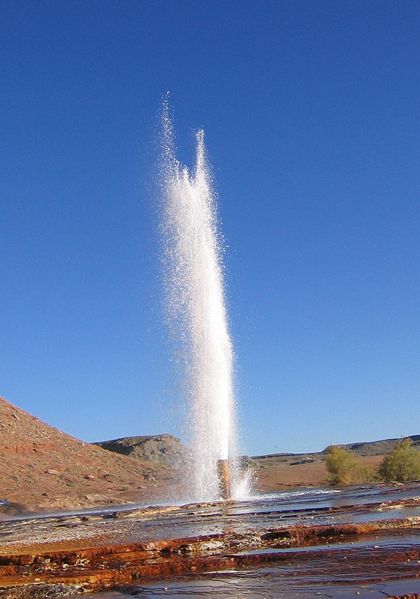7 December 2012
Cosmic ray muons watch for carbon leaks
Posted by kramsayer

Geologists fear sequestered carbon dioxide could leak back to the surface, like in this Utah geyser fueled by natural carbon dioxide. (Credit:Gouveia2 via wikimedia)
Out of sight, out of mind – that’s the essence of carbon sequestration, an emerging technology designed to fight climate change by packing liquefied carbon dioxide in underground rock formations.
But rocks have cracks, wells, holes, and other surprises that could let that carbon, so painstakingly injected, bubble back up to the surface again. Engineers and scientists need a way to watch for leaks that’s reliable and inexpensive. The solution, says geochemist Max Coleman of NASA’s Jet Propulsion Laboratory in Pasadena, Calif., is already falling from the skies.
Cosmic ray muons are particles, smaller than an atom, that fall to Earth from the upper atmosphere. Physics experiments tell us that muons have a lifetime of 2.2 millionths of a second.
But we see muons living much longer than 2.2 microseconds because of the theory of relativity, Coleman said at his poster Tuesday at the American Geophysical Union Fall Meeting in San Francisco. Because they fall at speeds near the speed of light, time slows down for muons and they’re able to exist long enough to penetrate the earth.
Only some muons make it very deep, though. Solid matter stops muons. Denser matter stops more muons. Scientists use cosmic ray muons like doctors use X-rays to peer through materials with different densities.
Coleman simulated the flow of muons through different geological materials and fluids.
Place muon detectors made of simple polystyrene plastic above and below a groundwater aquifer, he said, and you can figure out whether the water in between is fresh, salty, or saturated with injected carbon dioxide. It works because carbon dioxide is less dense than water and fresh water is less dense than brine.
A changing fluid density suggests a changing carbon dioxide concentration, i.e. a leak.
“Theoretically, it looks as though it will work,” Coleman said.
He’s just secured a $3 million grant from the UK’s Department of Energy and Climate Change (an “amazing-sounding” name, he said) to put his theory to the test. The first detectors will be installed in the UK at Boulby Mine, a mile-deep salt mine, and in a well near Newcastle. The funding, he said, came through only days ago.
“We think we can get these detectors underground, in wells, quite easily,” Coleman said, using horizontal drilling techniques borrowed from the oil industry. They’re fairly inexpensive, he said, and always on, since muons bombard the Earth at a constant rate.
The next question, of course, is what engineers do when they detect a leak.
“At least you know about it,” Coleman said. “You stop pumping, and you remedy it.”
Leaky rocks also present a challenge to oil companies, which pump water into the ground to force more oil to their wells. The water sometimes finds a crack or fault and takes a different path, Coleman said, instead of pushing the oil to the well, where the drillers want it to go.
Injecting carbon dioxide into the ground is a similar feat of geological engineering, he said.
“And if that goes wrong, [carbon dioxide] is going to be going somewhere else and we need to know that.”
-Paul Gabrielsen is a science communication graduate student at UC Santa Cruz










 GeoSpace is a blog on Earth and space science, managed by AGU’s Public Information staff. The blog features posts by AGU writers and guest contributors on all sorts of relevant science topics, but with a focus on new research and geo and space sciences-related stories that are currently in the news.
GeoSpace is a blog on Earth and space science, managed by AGU’s Public Information staff. The blog features posts by AGU writers and guest contributors on all sorts of relevant science topics, but with a focus on new research and geo and space sciences-related stories that are currently in the news.